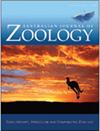Observations supporting parental care by a viviparous reptile: aggressive behaviour against predators demonstrated by Cunningham’s skinks
IF 1
4区 生物学
Q3 ZOOLOGY
引用次数: 3
Abstract
Abstract. Most reptiles exhibit no parental care and aggressive behaviour towards heterospecific predators has rarely been recorded in the natural environment. Several species of the subfamily Egerniinae are amongst the most highly social of all squamate reptiles, exhibiting stable social aggregations and high levels of long-term social and genetic monogamy. We have examined Cunningham’s skinks, Egernia cunninghami, over a three-year period during late January and early February (total 32 days) in the alpine region of New South Wales using video and thermal imaging. Four birthing sessions were witnessed during our field studies of social aggregations of skinks. Our observations monitored skink encounters, in the presence of offspring, with an eastern brown snake, Pseudonaja textilis (two separate encounters, one recorded by video/imaging) and 12 encounters with the Australian magpie, Gymnorhina tibicen. All events were associated with aggressive chasing and/or attack by adult skinks. The first snake encounter involved the active targeting of a recently born juvenile with the mother of the juvenile attacking the snake (running towards the snake, biting and remaining attached for several seconds). The second encounter (the following year) comprised two adult skinks attacking and biting a snake, Pseudonaja textilis. All magpie encounters resulted in chases by adult skinks.支持胎生爬行动物亲代照顾的观察:坎宁安石龙子对捕食者的攻击行为
摘要大多数爬行动物没有亲代照顾,对异种捕食者的攻击行为在自然环境中很少有记录。Egerniinae亚科的一些物种是所有有鳞爬行动物中最具社会性的,表现出稳定的社会聚集和高水平的长期社会和遗传一夫一妻制。在新南威尔士州的高山地区,我们用视频和热成像技术对坎宁安石龙子Egernia cunninghami进行了为期三年的研究,从1月底到2月初(共32天)。在我们对石龙子社会聚集的实地研究中,目睹了四次分娩过程。我们的观察监测了在后代存在的情况下,石龙子与东部棕色蛇Pseudonaja textilis(两次单独的接触,一次通过视频/成像记录)和12次与澳大利亚喜鹊(Gymnorhina tibicen)的接触。所有事件都与成年石龙子的攻击性追逐和/或攻击有关。第一次遇到蛇是主动瞄准一条刚出生的幼蛇,幼蛇的母亲攻击蛇(跑向蛇,撕咬并保持附着几秒钟)。第二次相遇(第二年)是两只成年石龙子攻击并咬了一条名叫伪石龙子的蛇。所有喜鹊遭遇的结果都是被成年石龙子追赶。
本文章由计算机程序翻译,如有差异,请以英文原文为准。
求助全文
约1分钟内获得全文
求助全文
来源期刊
CiteScore
2.40
自引率
0.00%
发文量
12
审稿时长
>12 weeks
期刊介绍:
Australian Journal of Zoology is an international journal publishing contributions on evolutionary, molecular and comparative zoology. The journal focuses on Australasian fauna but also includes high-quality research from any region that has broader practical or theoretical relevance or that demonstrates a conceptual advance to any aspect of zoology. Subject areas include, but are not limited to: anatomy, physiology, molecular biology, genetics, reproductive biology, developmental biology, parasitology, morphology, behaviour, ecology, zoogeography, systematics and evolution.
Australian Journal of Zoology is a valuable resource for professional zoologists, research scientists, resource managers, environmental consultants, students and amateurs interested in any aspect of the scientific study of animals.
Australian Journal of Zoology is published with the endorsement of the Commonwealth Scientific and Industrial Research Organisation (CSIRO) and the Australian Academy of Science.

 求助内容:
求助内容: 应助结果提醒方式:
应助结果提醒方式:


